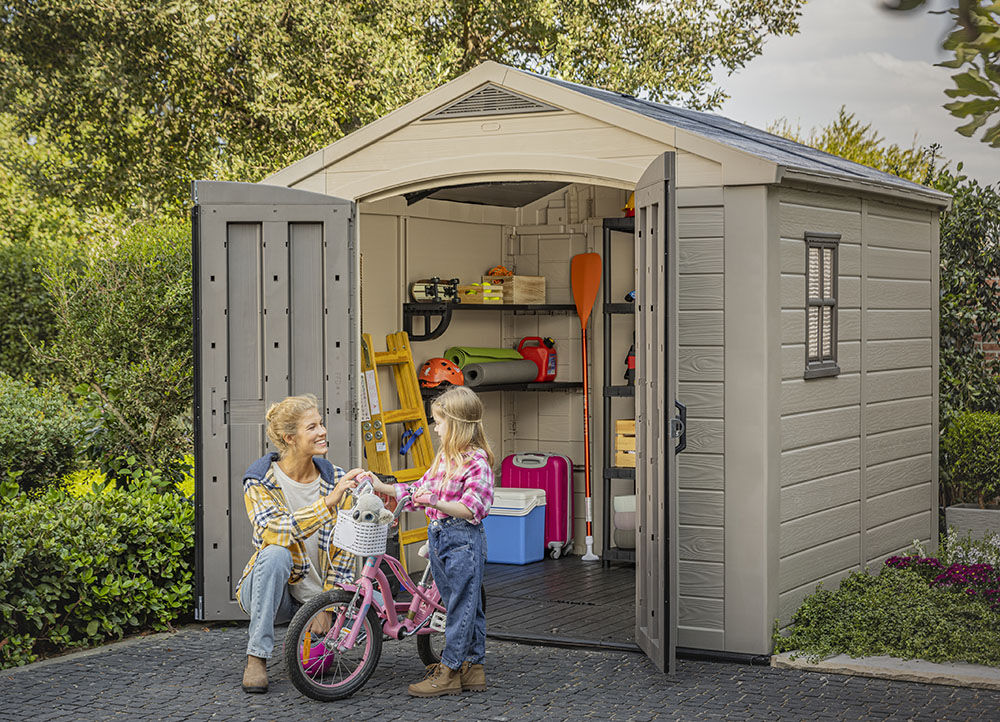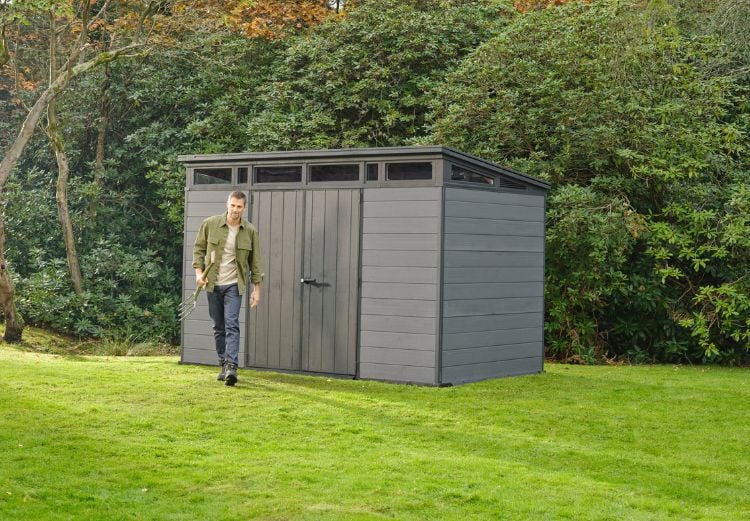
How to Choose the Perfect Shed Size for Your Storage Needs
If you’re adding a shed to your backyard, the first thing to do is figure out the size of shed you need. Whether you're storing your garden tools, making room for bikes and lawn gear, or setting up a hobby space, the right shed size can make your life a whole lot easier.
So, how do you choose the perfect size storage shed? You’ll want to think about what you're storing, how much space you have, what features you need, and yes, how it’ll look in your yard. This guide will walk you through everything, including real examples from our most popular Keter outdoor storage sheds in small, medium and large sizes. Let’s get into it.
Step 1: Take Inventory of What You’re Storing
Before you look at sizes or styles, start with the basics: what are you actually putting in this shed?
Walk through your garage, patio or backyard and make a list. Think beyond the obvious stuff like tools or trash bins. Are you storing patio cushions? Pool gear? Kids' bikes? Holiday decorations? Try to be specific. Instead of just writing "tools," note specifics like "hedge trimmer, leaf blower and shovel." This gives you a clearer picture of the space you’ll need.
It also helps to think ahead. If you plan to upgrade your lawn mower next year or know you'll need more storage for kids’ outdoor toys, factor that in now. It's easy to outgrow a shed.
Step 2: Get a Feel for Shed Sizes (With Real Examples)
Once you know what you're storing, it's time to match that list with a shed size that makes sense. The tricky part? “Small,” “medium” and “large” can mean different things depending on the brand. So, instead of guessing, let’s look at actual examples from popular Keter sheds to help you picture what each size can realistically hold.
Small Shed: Cortina Mega (Approx. 6x4)
.jpg?sw=1440)
A small shed like the Cortina Mega is ideal for tight spaces and basic storage needs, like a small bike shed. Think lawn tools, a push mower, outdoor cushions or recycling bins. It’s compact but still offers features like double doors and weather-resistant resin panels. Perfect for the homeowner who wants a no-fuss way to keep outdoor clutter under control.
Is a 6x4 shed big enough?
If you're just looking to store everyday tools or a few bulky items, yes. It’s a great size for making the most of a small backyard.
Medium Shed: Factor 8x6

Need more room to store yard equipment, organize your tools, or even set up a small workspace? The Factor 8x6 strikes a nice balance. With double doors for easy access and enough space for a mower, ladder, skis, or bulky bins, this shed gives you flexibility without overwhelming your backyard. It’s built with steel-reinforced resin panels for extra strength and stands up to the elements with ease.
Is an 8x6 shed big enough?
For a lot of homeowners, yes. It offers generous space for storage and projects but still fits comfortably in most suburban yards. It’s a solid choice if you want to do more than just stash stuff—maybe even pot a plant or two.
Large Shed: Cortina 11x7

If you need serious storage or plan to work inside your shed, something like the Cortina 11x7 is worth the space. You’ll have room for bikes, seasonal bins, power tools and even a riding mower, and you can still add shelves or a workbench. It’s a practical solution with a clean, modern look that doesn’t scream “storage shed.”
Is an 11x7 shed big enough?
Definitely. It’s one of the most versatile sizes for long-term storage, especially if you want space to grow into or use it for multiple purposes.
Step 3: Think About Features That Fit Your Life

Once you know the general size range you're working with, it’s time to narrow down the details. The right features can make your shed easier to use and last a lot longer.
- Doors: If you’re storing large items like bikes, trash bins or lawn equipment, wide double doors are necessary. They make loading and unloading way easier.
- Windows and Light: Natural light might not seem essential, but it makes a huge difference when you’re inside the shed. Look for windows or skylights if you’ll be in there often.
- Ventilation: A good shed should have airflow to help prevent moisture buildup and musty smells, especially if you’re storing cushions or cardboard boxes.
- Flooring: If you're going to store heavy gear, make sure your shed comes with a built-in floor. All Keter sheds do, and they're strong enough to support heavy equipment without warping or cracking.
- Style: It’s going in your backyard, so pick something you won’t mind looking at every day. Keter sheds have a clean, wood-look finish and come in neutral tones that blend with most homes.
- Maintenance Needs: Also, think about how much maintenance you want to do on your shed. Certain shed types require more work than others.
Once you’ve taken these factors into consideration, you’ll need to think through the shed material.
Step 4: Choose a Material That Works for Your Climate and Lifestyle
This step might seem like a no-brainer to you, as this seems like it’s about aesthetics, but it’s not. Here's a quick look at the pros and cons of shed material types.
- Wood sheds: Beautiful and traditional, but high maintenance. You’ll need to paint, seal and protect it from pests and rot.
- Metal sheds: Durable but can rust over time and heat up in the sun. It’s also less forgiving when it comes to dents.
- Resin sheds (like Keter): Wood-look and feel, tough and weather-resistant. It won’t rot, rust or peel, and you never have to repaint it. If you want a shed you can set and forget, resin is the way to go.
Take a look at our blog if you want a more in-depth look at the pros and cons of each shed material.
Step 5: Check for Permits, Budget and Site Prep
Before you buy, there are a few final boxes to check:
- Permits: Some cities or counties require permits for sheds over a certain size. Before you get too far, check your local zoning laws. It’s much easier to get it right the first time than to move or take down a shed later.
- Budget: Price often scales with size and features, but think long-term. A resin shed might cost a little more up front than a basic metal one, but you’ll save time and money on maintenance in the years ahead.
- Ground Prep: Every shed needs a flat, stable foundation.
If you want more information on shed foundations and the pros and cons of each, be sure to take a look at the guide here.
Final Step: Pick the Shed That Checks All Your Boxes
Once you've worked through what you're storing, what size makes sense and which features matter most, you're ready to choose a shed that fits your space and life.
Still not sure? Head to our Shed Comparison Page to explore all Keter shed styles side by side. You’ll get a better sense of what’s possible, and it’s a helpful way to compare features and designs before you decide.
Our recommendation is to get a Keter shed. Our sheds are made from sturdy resin that is easy to assemble and requires little to no maintenance. We sell large, medium and small sheds in many colors and offer special features like skylights and extra-wide double doors.

We build in a sustainable manner.
We use innovative materials and leading technologies to build planet-friendly products that last a lifetime.

.jpg?sw=20)







